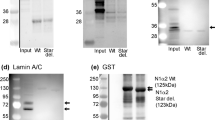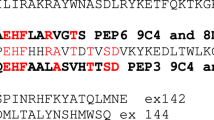Abstract
Molecular characterization of a novel gene designated Neuroendocrine-Specific Protein-Like-1 (Nspl1) had revealed that this gene is expressed as two transcripts, a 1.2 kb transcript found predominantly in skeletal muscle and a 2.1 kb transcript expressed in the brain. The exceptionally high level of skeletal muscle expression prompted us to determine where the protein is localized to skeletal muscle. In vitro studies were performed using two plasmid constructs that generate full-length Nspl1 muscle-specific protein fused to the green fluorescent protein (GFP). In one construct, the GFP cDNA was fused to the N-terminus of the Nspl1 cDNA while in the second construct, the GFP cDNA was fused to the C-terminus of the Nspl1 cDNA. Transfection of either plasmid into mononucleated myoblasts showed that the Nspl1-GFP chimeric protein was associated with intermediate filaments. This was confirmed by using an antibody to stain desmin and finding that GFP-Nspl1 colocalizes with desmin. Chick primary myoblasts were transfected with the chimeric cDNAs and allowed to differentiate into mature myotubes. Results from this analysis and the use of monoclonal antibody to stain α-actinin, further localized the Nspl1 protein to the Z-band of mature myotubes. Confocal microscopy of the myotubes containing Nspl1-GFP demonstrates that Nspl1 is distributed continuously throughout the Z-disks.
Similar content being viewed by others
References
Agbulut O. Li Z. Mouly V and Butler-Browne GS (1996) Analysis of skeletal and cardiac muscle from desmin knock-out and normal mice by high resolution separation of myosin heavy-chain isoforms. Biol Cell 88: 131–135.
Chen WY. Dhoot GK and Perry SV (1986) Characterization and fibre type distribution of a new myofibrillar protein of molecular weight 32 kDa. J Muscle Res Cell Motil 7: 517–526.
Cheng L. Fu J. Tsukamoto A and Hawley RG (1996) Use of green fluorescent protein variants to monitor gene transfer and expression in mammalian cells. Nature Biotechnol 14: 606–609.
Dabiri GA. Turnacioglu KK. Sanger JM and Sanger JW (1997) Myofibrillogenesis visualized in living embryonic cardiomyocytes. Proc Natl Acad Sci USA 94: 9493–9498.
Danowski BA. Imanaka-Yoshida K. Sanger JM and Sanger JW (1992) Costameres are sites of force transmission to the substratum in adult rat cardiomyocytes. J Cell Biol 118: 1411–1420.
Emerson C and Sweeney H (1997) Methods in Cell Biology, Vol. 52. Academic Press, New York.
Engel AG and Franzini-Armstrong C (1994) Myology, 2nd ed. McGraw-Hill, New York.
Fulton AB and Alftine C (1997) Organization of protein and mRNA for titin and other myofibril components during myofibrillogenesis in cultured chicken skeletal muscle. Cell Struct Funct 22: 51–58.
Galou M. Gao J. Humbert J. Mericskay M. Li Z. Paulin D and Vicart P (1997) The importance of intermediate filaments in the adaptation of tissues to mechanical stress: evidence from gene knockout studies. Biol Cell 89: 85–97.
Geisler JG (1998) The mapping, molecular characterization, cellular localization and functional studies of a novel gene with predominant muscle and brain expression. In: Biomedical Sciences (pp. 169). University of Tennessee, Knoxville, TN.
Geisler JG. Stubbs LJ. Wasserman WW and Mucenski ML (1998) Molecular cloning of a novel mouse gene with predominant muscle and neural expression. Mamm Genome 9: 274–282.
Geisterfer-Lowrance AA. Christe M. Conner DA. Ingwall JS. Schoen FJ. Seidman CE and Seidman JG (1996) A mouse model of familial hypertrophic cardiomyopathy. Science 272: 731–734.
Goll DE. Dayton WR, Singh I and Robson RM (1991) Studies of the alpha-actinin/actin interaction in the Z-disk by using calpain. J Biol Chem 266: 8501–8510.
Lazarides E (1980) Intermediate filaments as mechanical integrators of cellular space. Nature 283: 249–256.
Lazarides E. Gard DL. Granger BL. O'Connor CM. Breckler J and Danto SI (1982) Regulation of the assembly of the Z-disc in muscle cells. Prog Clin Biol Res 85 Pt B: 317–340.
Lazarides E. Granger BL. Gard DL. O'Connor CM. Breckler J. Price M and Danto SI (1982) Desmin-and vimentin-containing filaments and their role in the assembly of the Z disk in muscle cells. Cold Spring Harb Symp Quant Biol 46 Pt 1: 351–378.
Li Z. Colucci-Guyon E. Pincon-Raymond M. Mericskay M. Pournin S. Paulin D and Babinet C (1996) Cardiovascular lesions and skeletal myopathy in mice lacking desmin. Dev Biol 175: 362–326.
Li Z. Mericskay M. Agbulut O. Butler-Browne G. Carlsson L, Thornell LE. Babinet C and Paulin D (1997) Desmin is essential for the tensile strength and integrity of myofibrils but not for myogenic commitment, differentiation, and fusion of skeletal muscle. J Cell Biol 139: 129–144.
Lin Z. Hijikata T. Zhang Z. Choi J. Holtzer S. Sweeney HL and Holtzer H (1998) Dispensability of the actin-binding site and spectrin repeats for targeting sarcomeric alpha-actinin into maturing Z bands in vivo: implications for in vitro binding studies. Dev Biol 199: 291–308.
Lin Z. Lu MH. Schultheiss T. Choi J. Holtzer S. Dilullo C. Fischman DA and Holtzer H (1994) Sequential appearance of muscle-specific proteins in myoblasts as a function of time after cell division: evidence for a conserved myoblast differentiation program in skeletal muscle. Cell Motil Cytoskel 29: 1–19.
Lu MH. Dilullo C. Schultheiss T. Holtzer S. Murray JM. Choi J, Fischman DA and Holtzer H (1992) The vinculin/sarcomeric-α-actinin/α-actin nexus in cultured cardiac myocytes. J Cell Biol 117: 1007–1022.
Martin-Gallardo A. McCombie W. Gocayne J. Fitzgerald M. Wallace S. Lee B. Lamerdin J. Trapp S. Kelley J. Liu L-I. Dubnick M, Johnston-Dow L. Kerlavage A. De Jong P. Carrano A. Fields C and Venter C (1992) Automated DNA sequencing and analysis of 106 kilobases from human chromosome 19q13.3. Nature Genet 1: 34–39.
McKusick VA (1994) Mendelian Inheritance in Man, 11th ed. John Hopkins University Press, Baltimore/London.
Milner DJ. Weitzer G. Tran D. Bradley A and Capetanaki Y (1996) Disruption of muscle architecture and myocardial degeneration in mice lacking desmin. J Cell Biol 134: 1255–1270.
Morris EJ and Fulton AB (1994) Rearrangement of mRNAs for costamere proteins during costamere development in cultured skeletal muscle from chicken. J Cell Sci 107: 377–386.
Olson KR. McIntosh JR and Olmsted JB (1995) Analysis of MAP 4 function in living cells using green fluorescent protein (GFP) chimeras. J Cell Biol 130: 639–650.
Petropoulos CJ. Payne W. Salter DW and Hughes SH (1992) Appropriate in vivo expression of a muscle-specific promoter by using avian retroviral vectors for gene transfer (corrected) [published erratum in J Virol 66 (1992): 5175]. J Virol 66: 3391–3397.
Pines J (1995) GFP in mammalian cells. Trends Genet 11: 326–327.
PrasherDC(1995) UsingGFPto see the light. Trends Genet 11: 320–323.
Rhee D. Sanger JM and Sanger JW (1994) The premyofibril: evidence for its role in myofibrillogenesis. Cell Motil Cytoskel 28: 1–24.
Sanger JM. Dome JS. Hock RS. Mittal B and Sanger JW (1994) Occurrence of fibers and their association with talin in the cleavage furrows of PtK2 cells. Cell Motil Cytoskel 27: 26–40.
Sanger JM. Mittal B. Dome JS and Sanger JW (1989) Analysis of cell division using fluorescently labeled actin and myosin in living PtK2 cells. Cell Motil Cytoskel 14: 201–219.
Schultheiss T. Choi J. Lin ZX. Dilullo C. Cohen-Gould L. Fischman D and Holtzer H (1992) A sarcomeric α-actinin truncated at the carboxyl end induces the breakdown of stress fibers in PtK2 cells and the formation of nemaline-like bodies and breakdown of myofibrils in myotubes. Proc Natl Acad Sci USA 89: 9282–9286.
Schultheiss T. Lin ZX. Ishikawa H. Zamir I. Stoeckert CJ and Holtzer H (1991) Desmin/vimentin intermediate filaments are dispensable for many aspects of myogenesis. J Cell Biol 114: 953–966.
Schultheiss T. Lin ZX. Lu MH. Murray J. Fischman DA. Weber K, Masaki T. Imamura M and Holtzer H (1990) Differential distribution of subsets of myofibrillar proteins in cardiac nonstriated and striated myofibrils. J Cell Biol 110: 1159–1172.
Sjuve R. Arner A. Li Z. Mies B. Paulin D. Schmittner M and Small JV (1998) Mechanical alterations in smooth muscle from mice lacking desmin. J Muscle Res Cell Motil 19: 415–429.
Stubbs L. Carver E. Shannon M. Kim J. Geisler J. Generoso E, Stanford B. Dunn W. Mohrenweiser H. Zimmermann W. Watt S and Ashworth L (1996) Detailed comparative map of human chromosome 19q and related regions of the mouse genome. Genomics 35: 499–508.
Thornell L. Carlsson L. Li Z. Mericskay M and Paulin D (1997) Null mutation in the desmin gene gives rise to a cardiomyopathy. J Mol Cell Cardiol 29: 2107–2124.
Turnacioglu KK. Mittal B. Dabiri GA. Sanger JM and Sanger JW (1997a) An N-terminal fragment of titin coupled to green fluorescent protein localizes to the Z-bands in living muscle cells: overexpression leads to myofibril disassembly. Mol Biol Cell 8: 705–717.
Turnacioglu KK. Mittal B. Dabiri GA. Sanger JM and Sanger JW (1997b) Zeugmatin is part of the Z-band targeting region of titin. Cell Struct Funct 22: 73–82.
Van de Velde H. Roebroek A. Senden N. Ramaekers F and Van de Ven W (1994) NSP-encoded reticulons, neuroendocrine proteins of a novel gene family associated with membranes of the endoplasmic reticulum. J Cell Sci 107: 2403–2416.
Verma IM (1996) `Green light' for gene transfer. Nature Biotechnol 14: 576.
Vicart P. Dupret JM. Hazan J. Li Z. Gyapay G. Krishnamoorthy R, Weissenbach J. Fardeau M and Paulin D (1996) Human desmin gene: cDNA sequence. regional localization and exclusion of the locus in a familial desmin-related myopathy. Hum Genet 98: 422–429.
Vigoreaux JO (1994) The muscle Z band: lessons in stress management. J Muscle Res Cell Motil 15: 237–255.
Author information
Authors and Affiliations
Corresponding author
Rights and permissions
About this article
Cite this article
Geisler, J.G., Palmer, R.J., Stubbs, L.J. et al. Nspl1, a new Z-band-associated protein. J Muscle Res Cell Motil 20, 661–668 (1999). https://doi.org/10.1023/A:1005533013926
Issue Date:
DOI: https://doi.org/10.1023/A:1005533013926




